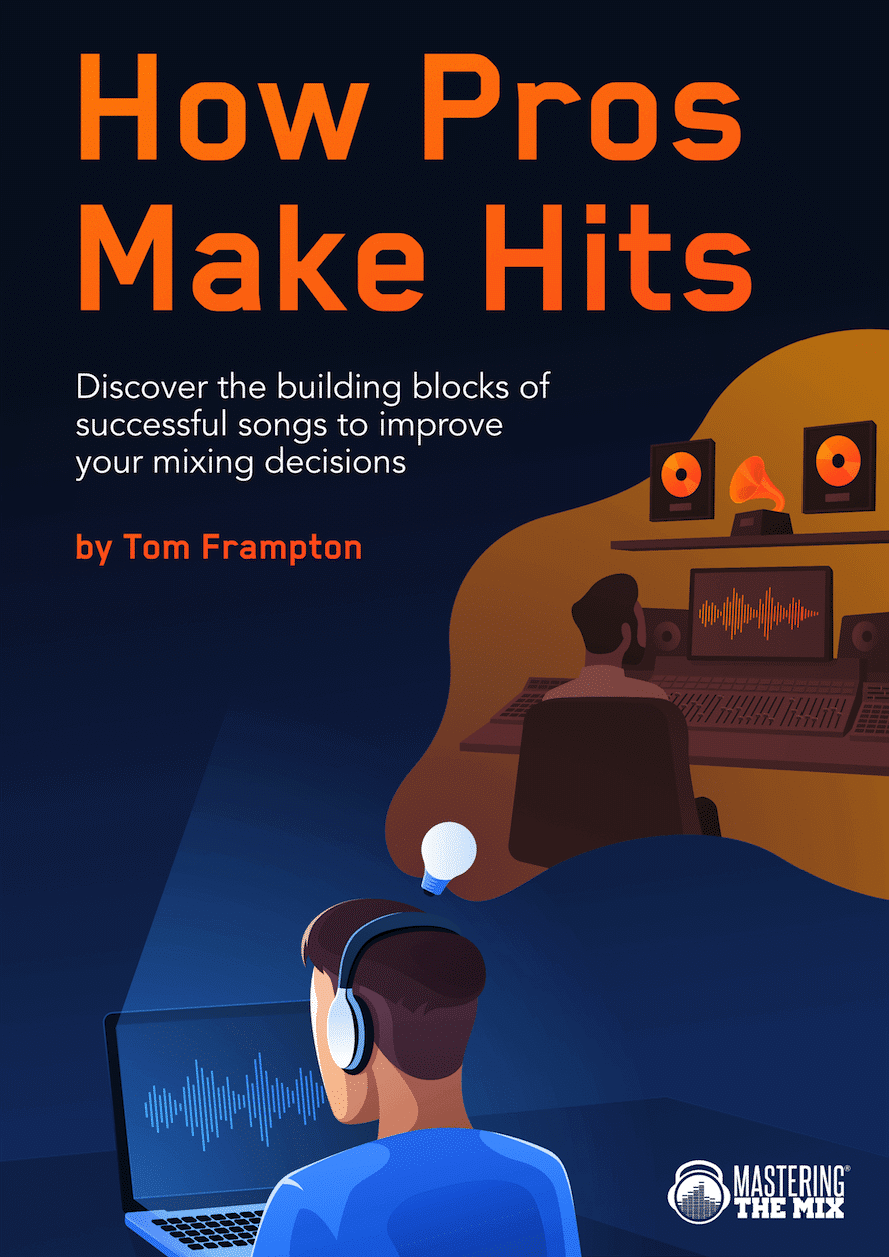This blog post is a chapter from How Pros Make Hits by Tom Frampton, posted with permission.
Electronic music group Major Lazer released Light It Up in 2015, and it became a classic floor-filler almost immediately. Light It Up was very successful in the global charts. It caught people’s attention as it was amongst the first ‘Moombahton’ infused tracks to hit the mainstream media. (‘Moombahton’ is a fusion genre of house music and reggaeton that was created by American DJ and producer Dave Nada in Washington, D.C., in 2009).
What was it about this track that caught people’s attention? What production techniques were used and how we can use them in our tracks?
Catchy and Novel
For a melody to capture a listener’s attention, it has to balance predictability with unpredictability. Familiarity allows the listener to digest the music without too much effort, drawing them into the song and making it memorable. The unpredictable aspect of the melody surprises them, which makes them more alert and focused while listening.
Let’s look at the vocal melody in the first verse of Light It Up. The blue writing is the first half of the verse; the orange is the second half.
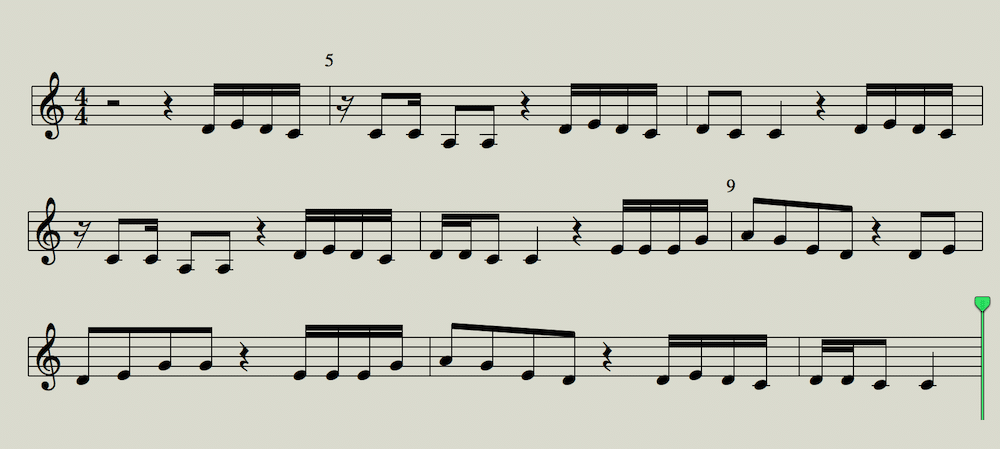
Simple repeated rhythms make it easy for the listener to digest and learn the melody; so they can sing it easily next time they hear it. The phrases go across the bar line, which adds just enough interest and complexity to make it novel.
Our brains are more sensitive to rhythm changes than harmony changes. The main difference between the blue first half and the orange second half is that the harmony changes. The melody line of ‘Soldier Baby’ in bar 5 goes down, whereas ‘War is raging’ in bar 9 goes up. The melody is entirely different, whereas the rhythm is only different on the first beat of each bar; the other three notes are 8th notes (quaver).
Next time you’re writing a melody try to use repetition and simplicity to draw in your listener. As you progress the tune, switch up the notes but keep a similar rhythm to add a surprise. Try to make your melodies stand out with a subtle, unexpected twist to the harmony and rhythm. This is a trial and error approach where you should give yourself the freedom to be as weird and experimental as you like in the pursuit of something different. You’ll know you’ve nailed it when your audience can sing along easily. The melodic phrases should be somewhat repetitive with both predictable and unpredictable characteristics.
Leveling The Bass Notes
Bass synth notes can sometimes get a little crazy with the loudness difference between them. It’s almost like individual notes resonate a few decibels louder than others. This can be down to the performance (live or midi) or just the way the synth responds to the notes being played. This can make a bass line sound too jumpy and out of control. If you don’t manage this dynamic, it can throw off your mastering compression and limiter at a later stage.
Keeping the bass notes consistent is something that Luca Pretolesi has done brilliantly in ‘Light It Up.’ I attended a workshop just after the release of the track where Luca demonstrated a multi-band compression technique. Using a dynamic EQ avoids splitting the frequencies into different bands so helps maintain the integrity of the audio. I’ll explain the concept of the method using a dynamic EQ as our tool of choice.
Below we have two notes in a bass line, note 1 and note 2. Note 2 is louder than note 1. We want to reduce the loudness of note 2 without affecting note 1. To do this, find the frequency of note 2 and create an EQ band with a high ‘Q,’ so it only affects that note. Then tweak the threshold, so the EQ is only triggered by the louder note.
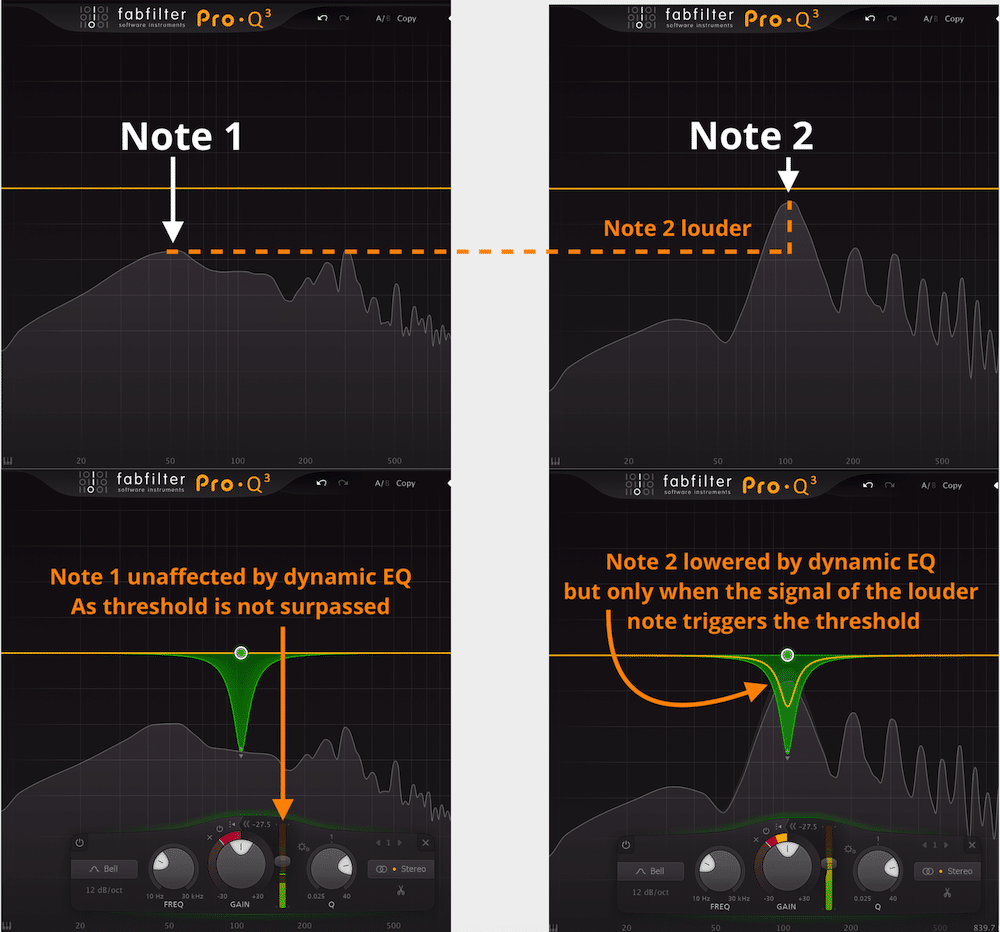
A great way to make sure you’ve set the perfect amount of control is to use a SUBPAC. The SUBPAC allows you to feel the intensity of the bass through vibration with it’s Physical-Sound® technology. In this circumstance, you’ll know you’ve hit the perfect settings when the vibration of note 1 and note 2 are the same.
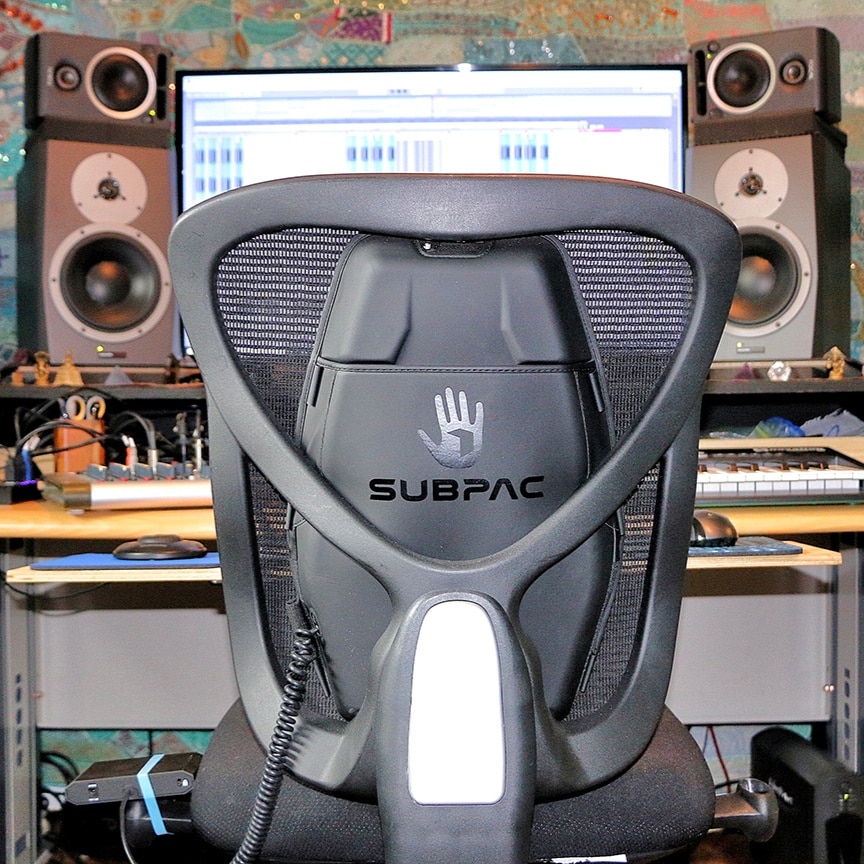
Stereo Spread
The climax of Light It Up is when the drop kicks in at 44 seconds. The lead trumpet reprises its intro melody an octave higher, and the bass synths take over the melody and rhythm that the plucked synth held during the verse. The drop has a super up-front and controlled midrange, while the high-frequencies and low-end have a fair amount of punch. This gives us a very aggressive and loud sound without ultimately compromising on dynamic range.
The bass/synth lead element (displayed in the infographic below in red) takes up a great deal of the frequency spectrum. This vast and cohesive sounding synth is most likely created using a couple of synth sounds that compliment each other and don’t fight for the same frequencies. If you want to layer synth sounds in your own production, try to mix them so they end up sounding like one single synth. It makes for a much cleaner mix and richer sound. Use Light It Up as a reference point to get your layered synths pudding cohesive.
This production was designed for club and festival sound systems. The low-end is completely mono, giving a rock-solid foundation to the mix. The sides are almost exclusively occupied by the reverb and delay effects during the drop. The focus of the drop comes down to three elements; the kick, the bass/synth lead and the lead trumpet. Everything else is secondary and only serves to add to the groove and vibe of the track.
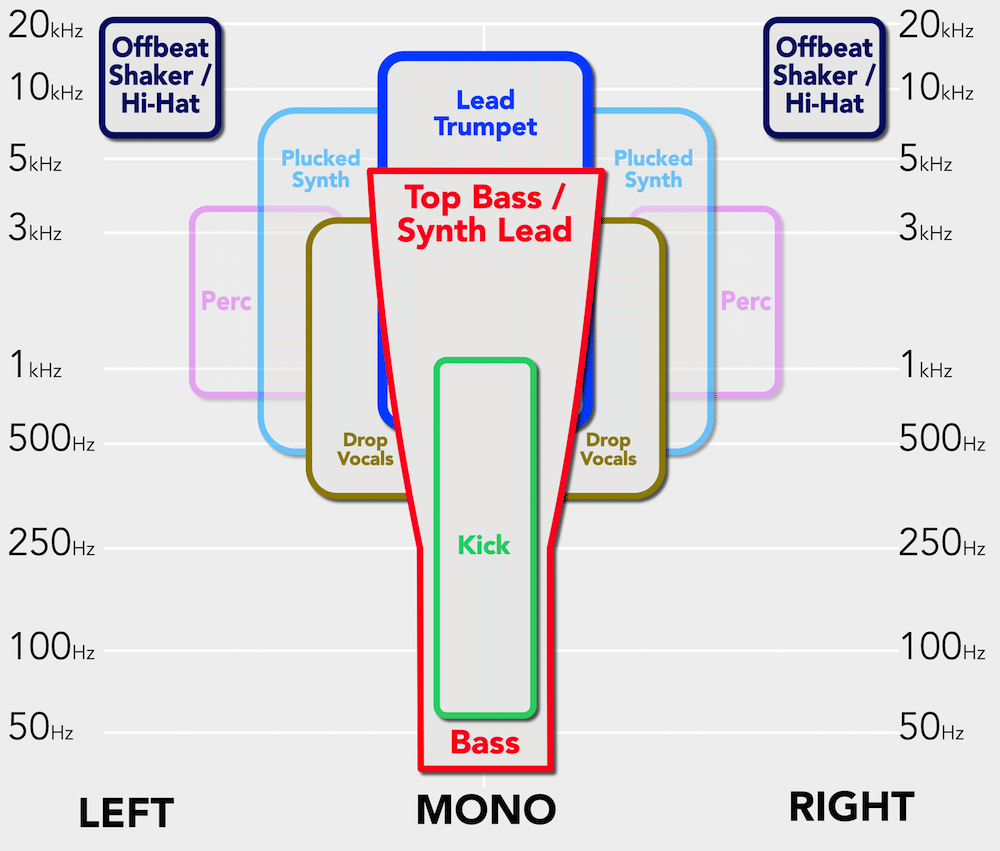
Technical Analysis
Below EXPOSE is showing that Light It Up is a super loud track, hitting -4.9 short-term LUFS during the loudest phrases. When a track is mastered this loud without considering the true peaks, clipping can occur. Clipping is even more likely when the track is converted to lossy file formats such as Mp3 or AAC for digital delivery (as most tracks are).

I can also see that they uploaded the same file to YouTube. The original is -7.4 LUFS, YouTube’s normalization algorithm turned the track down by 5.7dB… -7.4 LUFS – 5.7dB = -13.1LUFS (-13 LUFS is the average target streaming level for audio). Some artists like to upload a more dynamic and punchy master to YouTube, and some prefer the compressed and limited sound of loud masters. Knowing what YouTube does to your music empowers you to make the decision that’s right for you.
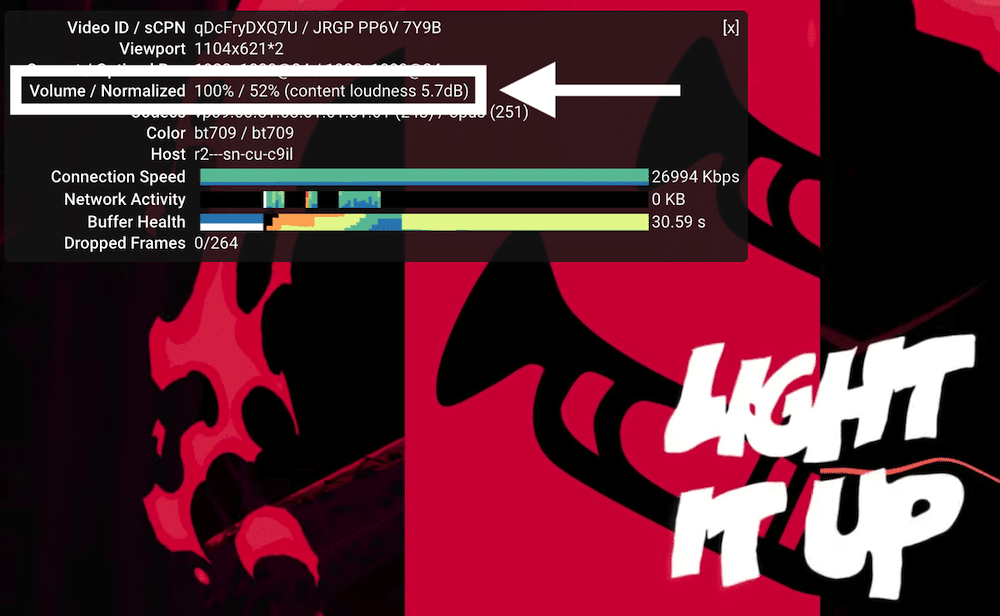
What Did We Learn?
- Next time you’re writing a melody try to use repetition and simplicity to draw in your listener. As you progress the tune, switch up the notes but keep a similar rhythm to add a surprise. Try to make your melodies stand out with a subtle, unexpected twist to the harmony and rhythm.
- Use a dynamic EQ to control the loudness of individual bass notes.
- If your track is intended for club and festival play, keep the low-end mono for a solid mix.
- Loudness comes at the expense of true peaks. Adjust the output on the limiter to give your final master some headroom.
Want To See More Songs Decoded?
This blog post is one of 40 chapters in ‘How Pros Make Hits’, an eBook created by Mastering The Mix. Music surrounds us. It’s everywhere. Your music has the potential to connect with millions of people. Don’t produce another second of music without first learning how these pros did it to give yourself the best chance of success. Visit the How Pros Make Hits webpage to download 5 free chapters now.
